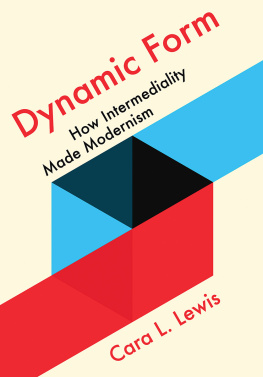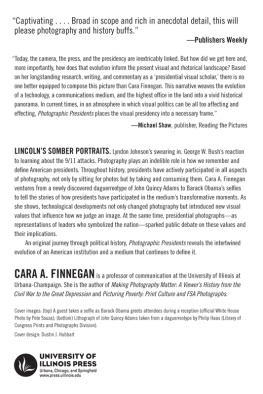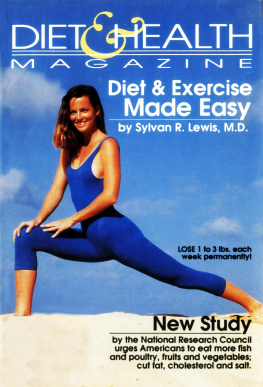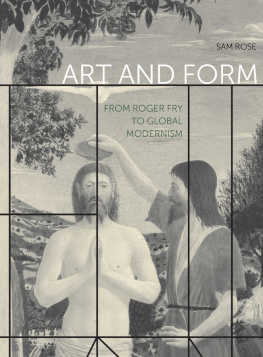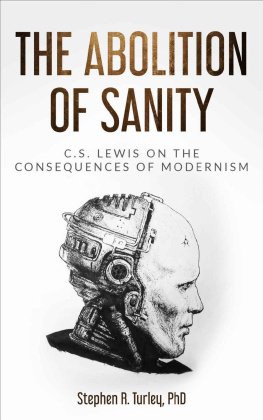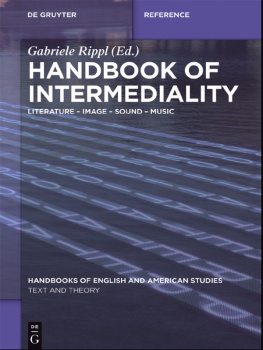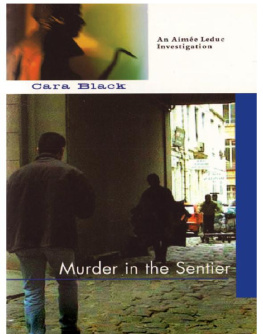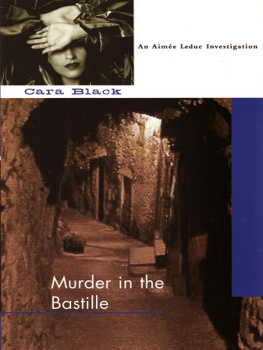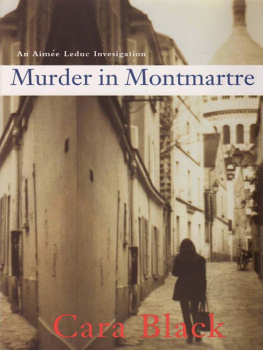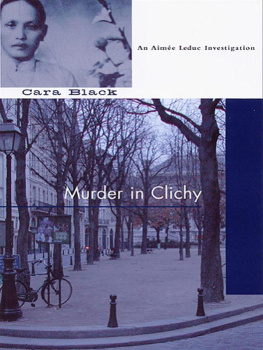Cara L. Lewis - Dynamic Form: How Intermediality Made Modernism
Here you can read online Cara L. Lewis - Dynamic Form: How Intermediality Made Modernism full text of the book (entire story) in english for free. Download pdf and epub, get meaning, cover and reviews about this ebook. year: 2020, publisher: Cornell University Press, genre: Art. Description of the work, (preface) as well as reviews are available. Best literature library LitArk.com created for fans of good reading and offers a wide selection of genres:
Romance novel
Science fiction
Adventure
Detective
Science
History
Home and family
Prose
Art
Politics
Computer
Non-fiction
Religion
Business
Children
Humor
Choose a favorite category and find really read worthwhile books. Enjoy immersion in the world of imagination, feel the emotions of the characters or learn something new for yourself, make an fascinating discovery.
- Book:Dynamic Form: How Intermediality Made Modernism
- Author:
- Publisher:Cornell University Press
- Genre:
- Year:2020
- Rating:3 / 5
- Favourites:Add to favourites
- Your mark:
- 60
- 1
- 2
- 3
- 4
- 5
Dynamic Form: How Intermediality Made Modernism: summary, description and annotation
We offer to read an annotation, description, summary or preface (depends on what the author of the book "Dynamic Form: How Intermediality Made Modernism" wrote himself). If you haven't found the necessary information about the book — write in the comments, we will try to find it.
Dynamic Form: How Intermediality Made Modernism — read online for free the complete book (whole text) full work
Below is the text of the book, divided by pages. System saving the place of the last page read, allows you to conveniently read the book "Dynamic Form: How Intermediality Made Modernism" online for free, without having to search again every time where you left off. Put a bookmark, and you can go to the page where you finished reading at any time.
Font size:
Interval:
Bookmark:
The idea for this book began at the University of Virginia as I was trying to get beyond ekphrasis. That I got there at alland anywhere sinceis due to the enthusiasm and guidance of Michael Levenson, and I feel immensely grateful to have him in my corner. It is also thanks to Rita Felskis incisive commentary: she knew what this book was about before I did, and to her I owe the title. To Jessica Feldman I owe its genesis in conversations that attempted to think literature and art together: thank you for your confidence in this book at the very beginning, and for reading chapters near the end. Thanks also to Victor Luftig for the heartening perspective checks and the chats about teaching, and to Jahan Ramazani and Stephen Arata for the steady encouragement. For their support in matters large and small during my time in Charlottesville and since then, I am indebted to Alison Booth, Stephen Cushman, Elizabeth Fowler, Bruce Holsinger, Clare Kinney, Victoria Olwell, Cynthia Wall, and the UVA Society of Fellows.
I am grateful for the assistance provided by three Summer Faculty Fellowships at Indiana University Northwest, and to my colleagues in the English Department there, especially Bill Allegrezza, Kate Gustafson, and Doug Swartz. Extra thanks go to Garin Cycholl and Brian OCamb for sustaining conversations and for their feedback on some of these chapters.
Mahinder Kingra, Mary Kate Murphy, Bethany Wasik, and everyone else at Cornell University Press have been wonderful to work with: helpful, game, and responsive. The comments and suggestions offered by Michael Thurston and an anonymous reader for the press were invaluable in getting this book into its final form, as was Florence Grants careful copyediting. The Beinecke Rare Book and Manuscript Library at Yale University provided crucial assistance with images. For their help with illustrations, I also wish to thank Kerry Annos at the Barnes Foundation and Emma Darbyshire at the Fitzwilliam Museum. Tremendous thanks to Roger Conover, both for his own work to preserve Mina Loys legacy and for permission to quote from her work.
Part of chapter 2 appeared in a slightly different version as Still Life in Motion: Mortal Form in Woolfs To the Lighthouse, Twentieth-CenturyLiterature 60, no. 4 (2014): 42354. Excerpts from To the Lighthouse by Virginia Woolf copyright 1927 by Houghton Mifflin Harcourt Publishing Company, renewed 1954 by Leonard Woolf. Reprinted by permission of Houghton Mifflin Harcourt Publishing Company. All rights reserved. Excerpts from Pictures from The Moment and Other Essays by Virginia Woolf copyright 1948 by Houghton Mifflin Harcourt Publishing Company, renewed 1976 by Marjorie T. Parsons. Reprinted by permission of Houghton Mifflin Harcourt Publishing Company. All rights reserved. Excerpts from The Diary of Virginia Woolf: Volume I 19151919 by Virginia Woolf published by The Hogarth Press are reproduced by permission of The Random House Group Ltd. 1977. Excerpts from The Diary of Virginia Woolf: Volume III 19251930 by Virginia Woolf published by The Hogarth Press are reproduced by permission of The Random House Group Ltd. 1980. Excerpts from A Change of Perspective: The Letters of Virginia Woolf: Volume III 19231928 by Virginia Woolf published by Chatto & Windus are reproduced by permission of The Random House Group Ltd. 1977. Permission to quote from the work of Virginia Woolf in the e-book has been granted by the Society of Authors as the Literary Representative of the Estate of Virginia Woolf.
Excerpts from The Diaries of Evelyn Waugh, The Letters of Evelyn Waugh, and images of three pages from the first edition of The Balance by Evelyn Waugh copyright 1927, 1976, and 1980 by Evelyn Waugh, used by permission of The Wylie Agency LLC. Excerpts from Vile Bodies by Evelyn Waugh, copyright 1958, reprinted in the United States by permission of Little, Brown and Company, an imprint of Hachette Book Group, Inc. Excerpts from Vile Bodies by Evelyn Waugh (Chapman and Hall 1930, Penguin Books 1938, 1996), copyright Evelyn Waugh, 1930, notes and introduction copyright Richard Jacobs, 1996, reproduced by permission of Penguin Books Ltd. Excerpts from The Loved One by Evelyn Waugh, copyright 1976, reprinted in the United States by permission of Little, Brown and Company, an imprint of Hachette Book Group, Inc. Excerpts from The Loved One by Evelyn Waugh (Chapman and Hall 1948, Penguin Books 1951, Penguin Classics 2000), copyright 1948 by Evelyn Waugh, reproduced by permission of Penguin Books Ltd. Excerpts from The Complete Stories of Evelyn Waugh by Evelyn Waugh, copyright 1998, reprinted in the United States by permission of Little, Brown and Company, an imprint of Hachette Book Group, Inc. Excerpts from The Balance and Excursion in Reality from The Complete Short Stories by Evelyn Waugh (Penguin Classics 2011), copyright The Estate of Laura Waugh, 2011, reproduced by permission of Penguin Books Ltd.
Many friends provided help and inspiration as this project was getting underway and as it was getting finished. Thanks to Emily Richmond Pollock for always believing I could get this done, and for nearly eighteen years of steadfast friendship. Thanks to Emily Hyde, Emily Setina, and Lily Sheehan for numerous talks and emails that helped me over the finish line. Wonderful conversations about visual art and literature with Alix Beeston and Amy Elkins have shaped my thinking, and their clear-eyed commentary significantly improved earlier drafts of these chapters. To Madigan Haley: it is a joy to think with you, and your generous friendship and careful reading have been indispensable in helping me to finish this book and to embark on new projects. Thanks to Kyle Frisina for being one of my favorite people to read with since the fourth grade: it is a pleasure and a privilege to have shared the making of this grownup book with you, and it has benefitted enormously from your sharp intelligence and your well-timed words of encouragement.
Thanks to my extended familiesGreg Chetel and Carolyn Graybeal, Lauren Chetel and John Lawson, Evelyn Graybeal, David Kronig, Stephen Nantier, Dick and Robin Porter, Russell and Ansley Campbell-Porter, Marguerite and West Bishopfor putting up with my work and for being proud of me. To my parents, Scott and Cappy Lewis: I owe you more than I could possibly account for here. Thank you for the unwavering love and support, and for making me a reader in the first place. To my sister Amanda, the instigator, motivator, and eternally buoying morning conversationalist: you are awesome, and I would care only half as much about art without your influence. Dan Chetels cooking and driving are the dynamic forces that have made this book possible. This book is betteras am Ibecause of your love: thank you, Dan, for everything.
Abel, Elizabeth. Virginia Woolf and the Fictions of Psychoanalysis. Chicago: University of Chicago Press, 1989.
Adams, Timothy Dow. Telling Lies in Modern American Autobiography. Chapel Hill: University of North Carolina Press, 1990.
Affron, Matthew. Decoration and Abstraction in Bloomsbury. In Dickerman, Inventing Abstraction, 18284.
Ahmed, Sara. Queer Phenomenology: Orientations, Objects, Others. Durham, NC: Duke University Press, 2006.
Albright, Daniel. Putting Modernism Together: Literature, Music, and Painting, 18721927. Baltimore: Johns Hopkins University Press, 2015.
Albright, Daniel. Untwisting the Serpent: Modernism in Music, Literature, and Other Arts. Chicago: University of Chicago Press, 2000.
Alkon, Paul K. Visual Rhetoric in The Autobiography of Alice B. Toklas. Critical Inquiry 1, no. 4 (June 1975): 84981.
Allen, Brooke. Vile Bodies
Font size:
Interval:
Bookmark:
Similar books «Dynamic Form: How Intermediality Made Modernism»
Look at similar books to Dynamic Form: How Intermediality Made Modernism. We have selected literature similar in name and meaning in the hope of providing readers with more options to find new, interesting, not yet read works.
Discussion, reviews of the book Dynamic Form: How Intermediality Made Modernism and just readers' own opinions. Leave your comments, write what you think about the work, its meaning or the main characters. Specify what exactly you liked and what you didn't like, and why you think so.

